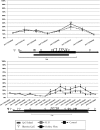Genome-wide DNA methylation identifies trophoblast invasion-related genes: Claudin-4 and Fucosyltransferase IV control mobility via altering matrix metalloproteinase activity
- PMID: 25697377
- PMCID: PMC4407676
- DOI: 10.1093/molehr/gav007
Genome-wide DNA methylation identifies trophoblast invasion-related genes: Claudin-4 and Fucosyltransferase IV control mobility via altering matrix metalloproteinase activity
Abstract
Previously we showed that extravillous cytotrophoblast (EVT) outgrowth and migration on a collagen gel explant model were affected by exposure to decidual natural killer cells (dNK). This study investigates the molecular causes behind this phenomenon. Genome wide DNA methylation of exposed and unexposed EVT was assessed using the Illumina Infinium HumanMethylation450 BeadChip array (450 K array). We identified 444 differentially methylated CpG loci in dNK-treated EVT compared with medium control (P < 0.05). The genes associated with these loci had critical biological roles in cellular development, cellular growth and proliferation, cell signaling, cellular assembly and organization by Ingenuity Pathway Analysis (IPA). Furthermore, 23 mobility-related genes were identified by IPA from dNK-treated EVT. Among these genes, CLDN4 (encoding claudin-4) and FUT4 (encoding fucosyltransferase IV) were chosen for follow-up studies because of their biological relevance from research on tumor cells. The results showed that the mRNA and protein expressions of both CLDN4 and FUT4 in dNK-treated EVT were significantly reduced compared with control (P < 0.01 for both CLDN4 and FUT4 mRNA expression; P < 0.001 for CLDN4 and P < 0.01 for FUT4 protein expression), and were inversely correlated with DNA methylation. Knocking down CLDN4 and FUT4 by small interfering RNA reduced trophoblast invasion, possibly through the altered matrix metalloproteinase (MMP)-2 and/or MMP-9 expression and activity. Taken together, dNK alter EVT mobility at least partially in association with an alteration of DNA methylation profile. Hypermethylation of CLDN4 and FUT4 reduces protein expression. CLDN4 and FUT4 are representative genes that participate in modulating trophoblast mobility.
Keywords: Claudin-4; DNA methylation; Fucosyltransferase IV; decidual natural killer cells; extravillous cytotrophoblast.
© The Author 2015. Published by Oxford University Press on behalf of the European Society of Human Reproduction and Embryology. All rights reserved. For Permissions, please email: journals.permissions@oup.com.
Figures







Similar articles
-
Decidual NK cells alter in vitro first trimester extravillous cytotrophoblast migration: a role for IFN-gamma.J Immunol. 2006 Dec 15;177(12):8522-30. doi: 10.4049/jimmunol.177.12.8522. J Immunol. 2006. PMID: 17142750
-
Sphingosine signalling regulates decidual NK cell angiogenic phenotype and trophoblast migration.Hum Reprod. 2013 Nov;28(11):3026-37. doi: 10.1093/humrep/det339. Epub 2013 Sep 3. Hum Reprod. 2013. PMID: 24001716
-
Expression of Gadd45α in human early placenta and its role in trophoblast invasion.Placenta. 2014 Jun;35(6):370-7. doi: 10.1016/j.placenta.2014.03.020. Epub 2014 Apr 12. Placenta. 2014. PMID: 24755561
-
The role of decidual natural killer cells in normal placentation and in the pathogenesis of preeclampsia.J Obstet Gynaecol Can. 2008 Jun;30(6):467-476. doi: 10.1016/S1701-2163(16)32862-6. J Obstet Gynaecol Can. 2008. PMID: 18611298 Review.
-
Decidual Natural Killer Cells: A Good Nanny at the Maternal-Fetal Interface During Early Pregnancy.Front Immunol. 2021 May 12;12:663660. doi: 10.3389/fimmu.2021.663660. eCollection 2021. Front Immunol. 2021. PMID: 34054831 Free PMC article. Review.
Cited by
-
Screening Candidate Genes Regulating Placental Development from Trophoblast Transcriptome at Early Pregnancy in Dazu Black Goats (Capra hircus).Animals (Basel). 2021 Jul 19;11(7):2132. doi: 10.3390/ani11072132. Animals (Basel). 2021. PMID: 34359260 Free PMC article.
-
The Role of Epigenetics in Placental Development and the Etiology of Preeclampsia.Int J Mol Sci. 2019 Jun 11;20(11):2837. doi: 10.3390/ijms20112837. Int J Mol Sci. 2019. PMID: 31212604 Free PMC article. Review.
-
Epigenetics of maternal-fetal interface immune microenvironment and placental related pregnancy complications.Front Immunol. 2025 Apr 3;16:1549839. doi: 10.3389/fimmu.2025.1549839. eCollection 2025. Front Immunol. 2025. PMID: 40248704 Free PMC article. Review.
-
Potential role of epigenetic mechanisms in regulation of trophoblast differentiation, migration, and invasion in the human placenta.Cell Adh Migr. 2016 Mar 3;10(1-2):126-35. doi: 10.1080/19336918.2015.1098800. Epub 2016 Jan 8. Cell Adh Migr. 2016. PMID: 26745760 Free PMC article. Review.
-
Alpha 1,3 N-Acetylgalactosaminyl Transferase (GTA) Impairs Invasion Potential of Trophoblast Cells in Preeclampsia.Int J Mol Sci. 2024 Jul 2;25(13):7287. doi: 10.3390/ijms25137287. Int J Mol Sci. 2024. PMID: 39000392 Free PMC article.
References
-
- Agarwal R, D'Souza T, Morin PJ. Claudin-3 and claudin-4 expression in ovarian epithelial cells enhances invasion and is associated with increased matrix metalloproteinase-2 activity. Cancer Res 2005;65:7378–7385. - PubMed
-
- Bertagnolo V, Benedusi M, Brugnoli F, Lanuti P, Marchisio M, Querzoli P, Capitani S. Phospholipase C-beta 2 promotes mitosis and migration of human breast cancer-derived cells. Carcinogenesis 2007;28:1638–1645. - PubMed
-
- Boireau S, Buchert M, Samuel MS, Pannequin J, Ryan JL, Choquet A, Chapuis H, Rebillard X, Avances C, Ernst M, et al. DNA-methylation-dependent alterations of claudin-4 expression in human bladder carcinoma. Carcinogenesis 2007;28:246–258. - PubMed
Publication types
MeSH terms
Substances
Grants and funding
LinkOut - more resources
Full Text Sources
Other Literature Sources
Molecular Biology Databases
Miscellaneous

